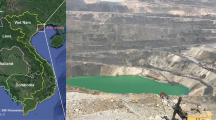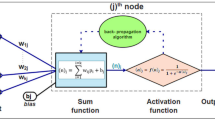Abstract
Tailoring the muckpile shape and its fragmentation to the requirements of the excavating equipment in surface mines can significantly improve the efficiency and savings through increased production, machine life and reduced maintenance. Considering the various blast parameters together to predict the throw is subtle and can lead to wrong conclusions. In this paper, a different approach was followed to combine the representational power of multilayer neural networks and various machine learning techniques to predict the throw of a bench blast using the data from a limestone mine located in central India. Then, using various analysis techniques, the training parameters have been adjusted to reduce the cross-validation error and increase the accuracy. Here, four different architectures of neural networks have been trained by different techniques, and the best model has been selected. The different machine learning techniques have been implemented on the basis of accuracy of the output. The sensitivity analysis has been done to get the relative importance of the variables in prediction of the output.











Similar content being viewed by others
References
Beattie T, Grant J (1988) The effect of inter-hole timing on heave. Symp Ser Australas Inst Min Metall 61:97–100
Hagan TN (1977) Good delay timing-prerequisite of efficient bench blasts. In: Proc Aus I.M.M., No. 263, p 47
Choudhary BS (2013) Firing patterns and its effect on muckpile shape parameters and fragmentation in quarry blasts. Int J Min Miner Eng 2(9):32–33
Rai P, Imperial FL, Choudhary BS (2006) A pattern for improvement. Quarry Manag J Spec Issue Drill Blast (September), b23–b30
Rai P, Choudhary BS (2008) A firing pattern for generating free face in a limestone Quarry—a case study. J Inst Eng (India) Min Eng Issue 88:3–8
Choudhary BS, Rai P (2013) Stemming plug and its effect on fragmentation and muckpile shape parameters. Int J Min Miner Eng 4(4):296–311
Chiappetta RF, Mammele ME (1988) Blasting analysis and design using high-speed photography. (Part III). In: Proceedings, Society of Mining Engineers conference, January 25–29, Phoenix, AZ, USA
Morhard RC, Chiappetta RF, Borg DG, Sterner VA (1987) Explosives and Rock Blasting. Atlas Powder Company, pp 159–203, 330–350, 662p
Chiappetta RF, Mammele ME (1987) Analytical high-speed photography to evaluate air decks, stemming retention and gas confinement in pre-splitting, reclamation and gross motion applications. In: Proceedings of 2nd international symposium on rock fragmentation by blasting, Keystone, Colorado, USA, pp 257–309
Hustrulid WA (1999) Blasting principles for open pit mining: general design concepts. Balkema
Anthony M (2001) Discrete mathematics of neural networks: selected topics (Vol. 8). Siam
Bishop CM (1995) Neural networks for pattern recognition. Oxford University Press, Oxford
Gurney K (1997) An introduction to neural networks. CRC Press, Boca Raton
Wasserman PD (1993) Advanced methods in neural computing. Wiley, New York
Werbos PJ (1990) Backpropagation through time: what it does and how to do it. Proc IEEE 78(10):1550–1560
Liu DC, Nocedal J (1989) On the limited memory BFGS method for large scale optimization. Math Program 45(1–3):503–528
Buckley AG (1978) A combined conjugate-gradient quasi-Newton minimization algorithm. Math Program 15(1):200–210
Levenberg K (1944) A method for the solution of certain non-linear problems in least squares. Q Appl Math 2(2):164–168
Marquardt DW (1963) An algorithm for least-squares estimation of nonlinear parameters. J Soc Ind Appl Math 11(2):431–441
Jolliffe IT (1986) Principal component analysis. Springer, Berlin, p 487
Peres-Neto PR, Jackson DA, Somers KM (2003) Giving meaningful interpretation to ordination axes: assessing loading significance in principal component analysis. Ecology 84(9):2347–2363
Bengio Y, Lamblin P, Popovici D, Larochelle H (2007) Greedy layer-wise training of deep networks. Adv Neural Inform Process Syst 19:153
Vincent P, Larochelle H, Lajoie I, Bengio Y, Manzagol PA (2010) Stacked denoising autoencoders: learning useful representations in a deep network with a local denoising criterion. J Mach Learn Res 11:3371–3408
Srivastava N, Hinton G, Krizhevsky A, Sutskever I, Salakhutdinov R (2014) Dropout: a simple way to prevent neural networks from overfitting. J Mach Learn Res 15(1):1929–1958
Hastie T, Tibshirani R, Friedman J (2009) Neural networks. Springer, New York, 400pp
Garson DG (1991) Interpreting neural network connection weights. Artif Intell Expert 6(4):46–51
Goh ATC (1995) Back-propagation neural networks for modeling complex systems. Artif Intell Eng 9(3):143–151
Olden JD, Jackson DA (2002) Illuminating the “black box”: a randomization approach for understanding variable contributions in artificial neural networks. Ecol Model 154(1):135–150
Olden JD, Joy MK, Death RG (2004) An accurate comparison of methods for quantifying variable importance in artificial neural networks using simulated data. Ecol Model 178(3):389–397
Lek S, Delacoste M, Baran P, Dimopoulos I, Lauga J, Aulagnier S (1996) Application of neural networks to modelling nonlinear relationships in ecology. Ecol Model 90(1):39–52
Gevrey M, Dimopoulos I, Lek S (2003) Review and comparison of methods to study the contribution of variables in artificial neural network models. Ecol Model 160(3):249–264
Author information
Authors and Affiliations
Corresponding author
Rights and permissions
About this article
Cite this article
Murthy, V.M.S.R., Kumar, A. & Sinha, P.K. Prediction of throw in bench blasting using neural networks: an approach. Neural Comput & Applic 29, 143–156 (2018). https://doi.org/10.1007/s00521-016-2423-4
Received:
Accepted:
Published:
Issue Date:
DOI: https://doi.org/10.1007/s00521-016-2423-4




